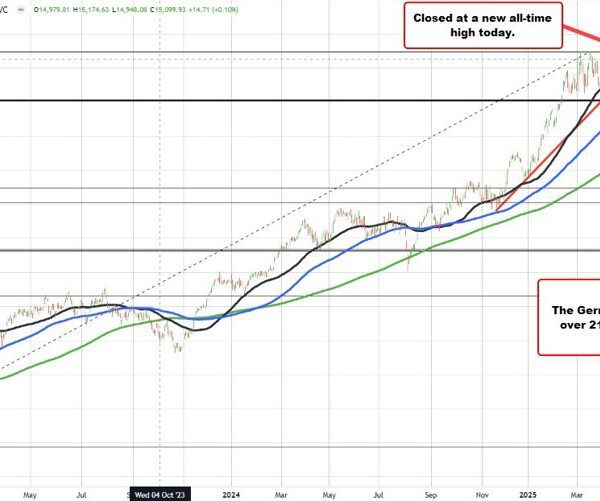Once a week, most weeks, the ground in Chisholm, Minn., shudders underfoot.
“When they blast over here, we can feel it in town over there,” Jed Holewa, a City Council member, explained as he looked out over the pit of the Hibbing Taconite mine, a machine-made canyon of flint-colored earth extending to the hills just southwest of town.
The low rumble of controlled explosions is reassuring in an area where few livelihoods are more than a couple of degrees removed from the mines. But this month the ground beneath the Iron Range has begun to shift in a very different way.
The sedimentary rock known as taconite, found in abundance in northern Minnesota, yields most of the United States’ iron ore, which in turn is made into steel used by the American auto industry. Thus the seismic effects of President Trump’s March 26 announcement of a 25 percent tariff on all cars and auto parts imported into the United States. The measure is meant to benefit the domestic auto industry, and has earned praise from labor leaders. But analysts predict it will most likely throw that industry into near-term turmoil, and several domestic automakers saw their stock fall last week after Mr. Trump’s announcement.
The tariff announcement comes amid a brewing trade war between the United States and Canada prompted by Mr. Trump’s earlier threats to impose broad tariffs on America’s northern neighbor and its longstanding ally and trading partner. Canada has responded with its own tariffs.
At the same time, Cleveland-Cliffs, the steel conglomerate that controls Hibbing Taconite and other nearby mines, has announced plans to idle production lines and lay off more than 600 mine workers in the region, citing a softening of demand for cars. Mr. Holewa, a diesel mechanic at Hibbing Taconite, was among those waiting to hear his fate.
The son and grandson of miners, Mr. Holewa is well acquainted with both the fortunes and misfortunes of the industry, in which substantial union salaries go hand in hand with risk and uncertainty. His maternal grandfather was killed on the job, crushed by a haul truck. His father was laid off from a mine in Eveleth, Minn., in the 1980s, during the industry’s darkest period. The high points of its uneven recovery were memorialized in the model years of the Fords his family bought when he was growing up: a 1988 Tempo, a 1994 F-150.
Mr. Holewa, a Republican, is also indicative of the shifting politics of the Iron Range, where Mr. Trump made dramatic gains over previous Republican candidates in 2016 — the beginning of a collapse of a onetime rural Democratic stronghold where Republicans have since claimed most of the region’s seats in the State Legislature.
Mr. Holewa, who knocked on doors for Mr. Trump, was quick to note that the conditions that caused the layoffs preceded Mr. Trump’s tariff announcements.
“This has nothing to do with the tariffs,” he said. “Look at the price of vehicles right now. Sales are down. Lots are full.”
But a representative of Cleveland-Cliffs, whose chief executive has vocally supported Mr. Trump’s trade policy, has told local officials that the tariffs could potentially prolong the layoffs, according to Larry Cuffe Jr., the mayor of Virginia, Minn., another Iron Range town. The company did not respond to requests for comment.
And observers of Minnesota industry say the layoffs — the most serious non-Covid-related job cuts the Iron Range’s mines have experienced in a decade — are a reminder of how uniquely exposed the region is to Mr. Trump’s radical trade experiments: how much it stands to gain or lose — or both — from the shocks the president hopes to deliver to the system.
“It’s throwing a big uncertainty into the supply chain,” said Bob Kill, the chief executive of Enterprise Minnesota, an organization that assists manufacturers in the state. “You see it at the Iron Range happening with raw material.”
The range should in theory benefit from the expanded tariffs on imported steel that Mr. Trump announced in February. But it is also sensitive to shifts and uncertainty in the auto market, as this month’s layoffs have shown. And a trade war with Canada could upend many businesses in the region, which is closer to the Canadian border than to Minneapolis, and raise the price of an array of goods and services, including electricity and dairy products.
“We’re going to ride it out and see,” said Mike Jugovich, a county commissioner and a retired Hibbing Taconite miner in St. Louis County, which encompasses most of the Iron Range. “We don’t have a real choice in the matter. We’re joined at the hip to the tariffs.”
Boomtowns both wild and worldly
Most of America’s domestically produced iron has come from northern Minnesota since the turn of the 20th century, when steam shovels backed by Rockefeller and Carnegie money transformed miles of boreal forest into a muddy, sooty sprawl of hard-living frontier camps.
In those years, the mines drew thousands of immigrants from Finland and Croatia and everywhere in between, producing a boomtown culture both wild and cosmopolitan — a place where “the Babel of more than 30 different alien tongues mingles with the crash and clank of machinery,” as a federal immigration agent wrote in a 1912 report.
More than a century later, the Iron Range remains culturally distinct from the rest of the state. In towns like Chisholm, onion-domed churches punctuate residential neighborhoods, red-sauce Italian restaurants line the main drags and bars keep dusty bottles of pelinkovac, a Balkan wormwood liqueur, on the top shelf for the old-timers.
Many go back generations in the mines, their family trees intertwined with histories of corporate consolidations and labor strikes, of booms and, more often, busts.
“Anybody who’s lived on the range understands that these are the cycles that occur,” said Pete Hyduke, the mayor of Hibbing, just south of Chisholm, who went into government after he was laid off from his mining job in the 1980s.
Fewer than half as many miners are now employed on the Iron Range as were at the beginning of the ’80s, when jobs fell victim to technological improvements and to the decline of the domestic steel industry, undercut by cheaper imports and the migration of manufacturing away from the United States.
Today, the range’s fortunes turn largely on trade policy, the push and pull of free-trade agreements and tariffs. This became starkly evident in the 2010s, when China, whose steel production had grown to eclipse every other country’s, began flooding the international market, cutting global prices in half by 2015 and prompting thousands of layoffs at Minnesota’s mines. Since then, “the Iron Range has known that tariffs are important for our domestic production and survival,” said Cal Warwas, a Republican state representative and a steelworker from Clinton Township.
The Obama administration eventually imposed stiff anti-dumping tariffs on China, but the episode exacerbated local discontent with the Democratic Party. Iron Rangers’ fiercely pro-union politics had for decades made the region the great rural redoubt of the Democratic-Farmer-Labor Party, Minnesota’s variant on the Democratic Party. But in a socially conservative area whose fortunes rest on resource extraction, many found themselves dissenting from the D.F.L. on environmental protection and social issues, and convinced that an increasingly urban and suburban party was insufficiently attentive to the range’s economic concerns.
“They’ve become way too woke for me,” said Mr. Cuffe, the Virginia mayor, who left the D.F.L. and endorsed Mr. Trump in 2016.
Mr. Trump outperformed previous Republican candidates in the region in 2016, and endeared himself further by imposing 25 percent tariffs on Chinese steel during his first term. Today, the region’s delegation to the State Legislature is entirely Republican save for one state senator.
Hope and anxiety over tariffs
Tariffs on China are broadly supported by Republicans and Democrats alike on the Iron Range. But Mr. Trump’s promises to levy 25 percent tariffs on Canada and similar penalties on cars and car parts imported to the United States have raised alarm.
“I’m very supportive of protectionist policies on industries that matter to our national defense,” said Grant Hauschild, a state senator from Minnesota’s Canada-bordering Third District, and the one remaining Democrat in the Iron Range’s legislative delegation. “However, haphazard, across-the-board tariffs on everything, everywhere, all at once, on allies as well as adversaries, is not the best policy.”
A core issue, manufacturing experts say, is that even the domestic industries Mr. Trump wants to bolster now rely on complex supply chains that run back and forth across borders with regional trading partners, which are difficult to untangle in places like the Great Lakes region.
This is particularly true of the American auto industry, which “is highly dependent on a robust North American supply chain that often involves cross-border trade,” said Matteo Fini, an analyst at S&P Global. American-made catalytic converters are shipped to Canada for installation in exhaust systems that are then shipped back to the United States. American lithium is made into cathodes in Canada, which are assembled into battery packs in the United States and then sent north again for vehicle production.
Jolts to this system may well be felt on the Iron Range, and broader tariffs on Canada, as well as any reciprocal tariffs Canada imposes, will affect the region in other ways. Minnesota utilities buy Canadian hydropower. Paper mills run on Canadian wood pulp. Tourism and Great Lakes shipping, other mainstays of the regional economy, rely on easy border transit.
The local implications of a trade war are severe enough that some of Mr. Trump’s supporters on the range have concluded that despite his years of tariff evangelism, the president’s recent threats must be a bluff.
“I think it’s just a negotiating tactic to try to get some compromise,” said Mr. Cuffe. He paused. “I’m hoping that’s the case.”
For local Democrats, however, Mr. Trump’s antagonism of their northern neighbors has added confusion to their discontent with the president.
“All this stuff about Canada — I mean, where did it come from?” said Mary Beth Perreira, a retired public health nurse in Hibbing. “If you have a brain, you know that we’re going to pay for it all.”
But others have begun to come around to Mr. Trump’s vision.
“I don’t mind them hitting Canada,” said Tim Simpson, a retired truck driver from Hibbing.
Mr. Simpson moved away from the region for a time in the 1980s, after losing his job at a local taconite mine. A political independent, he voted for Mr. Trump in 2016 but not in 2024.
Still, he said the president’s trade-war bluster might be good for the Iron Range.
“I hope it straightens a lot of stuff out, and we do get a lot of them jobs back,” he said. “We’ve been losing them since the ’60s, since I was a kid.”















